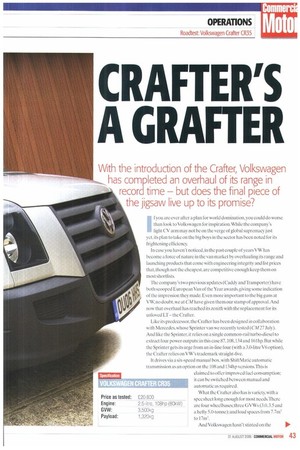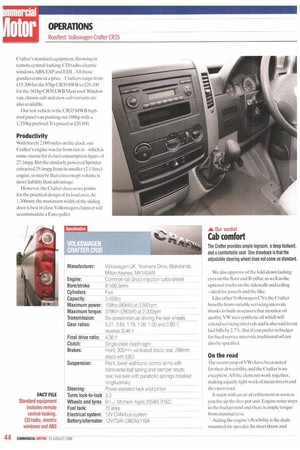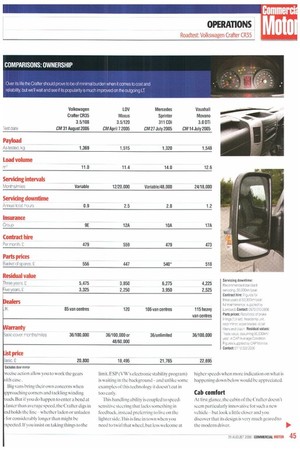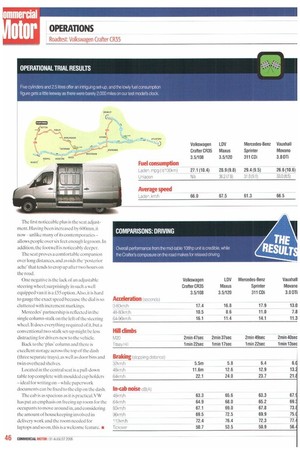CRAFTER'S A GRAFTER
Page 43

Page 44

Page 45

Page 46

If you've noticed an error in this article please click here to report it so we can fix it.
With the introduction of the Crafter, Volkswagen has completed an overhaul of its range in record time — but does the final piece of the jigsaw live up to its promise?
If you are ever after a plan for world domination, you could do worse than look to Volkswagen for inspiration. While the company's light CV arm may not be on the verge of global supremacy just yet, its plan to take on the big boys in the sector has been noted for its frightening efficiency.
In case you haven't noticed, in the past couple of years VW has become a force of nature in the van market by overhauling its range and launching products that come with engineering integrity and list prices that, though not the cheapest, are competitive enough keep them on most shortlists.
The company's two previous updates (Caddy and Transporter) have both scooped European Van of the Year awards, giving some indication of the impression they made. Even more important to the big guns at VW,no doubt, we at CM have given them our stamp of approval. And now that overhaul has reached its zenith with the replacement for its unloved LT— the Crafter.
Like its predecessor, the Crafter has been designed in collaboration with Mercedes, whose Sprinter van we recently tested (CM 27 July). And like the Sprinter, it relies on a single common-rail turbo-diesel to extract four power outputs: in this case 87,108,134 and 161hp. But while the Sprinter gets its urge from an in-line four (with a 3.0-litre V6 option), the Crafter relies on VW's trademark straight-five.
It drives via a six-speed manual box, with ShiftMatic automatic transmission as an option on the 108 and 134hp versions This is claimed to offer improved fuel consumption; it can be switched between manual and automatic as required.
What the Crafter also has is variety, with a Price as tested: E20,800 spec sheet long enough for most needs:There Engine: 2.5-litre, 108hp (80kVV) are four wheelbases; three G VWs (3.0,3.5 and GVW: 3,500kg a hefty 5.0-tonne):and load spaces from 7.7m' Payload: 1,320kg to 17ml.
And Volkswagen hasn't stinted on the Crafter's standard equipment, throwing in remote central-locking.CD/radio, electric windows,ABS,ESP and EDL. All those goodies come at a price— Crafters range from £15,300 for the 87hp CR30 SWB to t28,100 for the 161hp CR50 LWB Maxi roof.Window van.chassis-cab and crew-cab variants are also available.
Our test vehicle is the CR35 MWB highroof panel van pushing out 108hp with a 1,320kg payload. It's priced at £20,800.
Productivity
With barely 2,000 miles on the clock, our Crafter's engine was far from run in —which is some excuse for its fuel consumption figure of 27.1inpg.But the similarly powered Sprinter extracted 29.4mpg from its smaller (2.1litre) engine, so maybe that extra swept volume is more liability than advantage.
However, the Crafter does score points for the practical design of its load area. At 1,300mm, the maximum width of the sliding door is best in class; Volkswagen claims it will accommodate a Euro pallet. We also approve of the fold-down lashing eyes on the floor and B-pillar, as well as the optional tracks on the sidewalls and ceiling — ideal for parcels and the like.
Like other Volkswagen CVs, the Crafter benefits from variable servicing intervals thanks to built-in sensors that monitor oil quality. VW uses synthetic oil which will extend servicing intervals and is also said to cut fuel bills by 2.7%. But if you prefer to budget for fixed service intervals, traditional oil can also be specified.
On the road
The recent crop of VWs have been noted for their driveability, and the Crafter is no exception.All the elements work together, making equally light work of mean streets and the open road.
It starts with an air of refinement as soon as you lire up the five-pot unit. Engine noise stays in the background and there is ample torque from minimal revs.
Aiding the engine's flexibility is the dashmounted six-speeder. Its short throw and recise action allow you to work the gears with ease.
Big vans bring their own concerns when pproaching corners and tackling winding oads. But if you do happen to enter a bend at faster than average speed, the Crafter digs in nd holds the line— whether laden or unladen for considerably longer than might he xpected. If you insist on taking things to the limit, ESP (VW's electronic stability program) is waiting in the background— and unlike some examples of this technology it doesn't cut in too early.
This handling ability is coupled to speedsensitive steering that lacks something in feedback, instead preferring to live on the lighter side:Ibis is fine in town when you need to twirl that wheel, but less welcome at higher speeds when more indication on what is happening down below would be appreciated.
Cab comfort
Al first glance, the cabin of the Crafter doesn't seem particularly innovative for such a new vehicle—but look a little closer and you discover that its design is very much geared to the modern driver. The first noticeable plus is the seat adjustment. Having been increased by 6001/1[11, it now unlike many of its contemporariesallows people over six feet enough legroom. In addition, the footwell is noticeably deeper.
The seat proves a comfortable companion over long distances, and avoids the 'posterior ache' that tends to crop up after two hours on the road.
One negative is the lack of an adjustable steering wheel; surprisingly in such a well equipped van it is a £55 option. Also. it is hard to gauge the exact speed because the dial is so cluttered with increment markings.
Mercedes' partnership is reflected in the single column-stalk on the left of the steering wheel. It does everything required of it, but a conventional two-stalk set-up might be less distracting for drivers new to the vehicle.
Back to the 'plus' column and there is excellent storage across the top of the dash (three separate trays), as well as door bins and twin overhead shelves.
Located in the central seat is a pull-down table top complete with moulded cup holders ideal for writing on while paperwork documents can be fixed to the clip on the dash.
The cab is as spacious as it is practical.VW has put an emphasis on freeing up room for the occupants to move around in, and considering the amount of housekeeping involved in delivery work and the room needed for laptops and so on, this is a welcome feature. •


















































































































































































